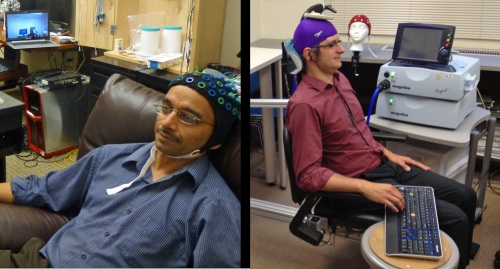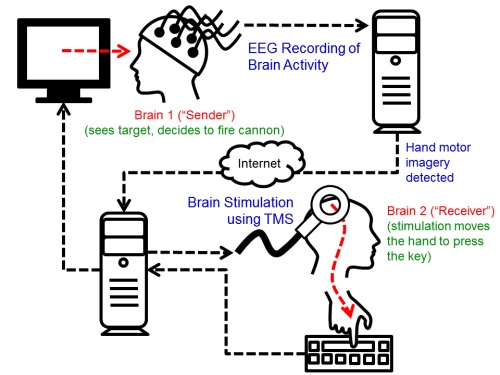Scientists, engineers, computer programmers, and the like are all celebrating the recent breakthrough made by a pair of researchers out of the University of Washington in which one was able to control the other’s movements via thought control in the first human noninvasive brain-to-brain interface ever recorded.

University of Washington researchers demonstrate the first-ever human brain-to-brain interface.
Duke University researchers have demonstrated brain-to-brain communication between rats before, and Harvard researchers have proven the technology works between human and rat, but this marks the first occasion in which it’s been successfully used on a pair of humans.
During the demonstration, researcher Rajesh Rao sat in his lab wearing a cap with electrodes hooked up to an electroencephalography machine, a device that reads electrical activity in the brain. Research partner Andrea Stocco, meanwhile, was located across campus wearing a purple swim cap marked with the stimulation site for the transcranial magnetic stimulation coil that was placed directly over his left motor cortex, which controls hand movement.
The two set up a Skype connection so that the labs could coordinate with one another, though neither could see the other’s screen.
Rao was given the task of playing a video on his computer screen using thought control. Whenever he was supposed to fire a cannon at a target, he had to imagine moving his right hand (he could not actually move his hand at the time). Doing this would cause the cursor to hit the “fire” button.
Almost instantly, Stocco, who wore noise-canceling earbuds and couldn’t see the computer screen, involuntarily moved his right index finger to push the space bar on the keyboard in front of him—as though he were firing the cannon in the video game.

Schematic of the experiment’s cycle.
Upon review, Stocco said that the sensation of his moving involuntarily felt like a nervous tic.
“It was both exciting and eerie to watch an imagined action from my brain get translated into actual action by another brain,” Rao said. “This was basically a one-way flow of information from my brain to his. The next step is having a more equitable two-way conversation directly between the two brains.”
The technology the duo used is actually pretty well known: electroencephalography, or EEG. It’s typically used by clinicians and researchers for the purpose of noninvasively recording brain activity. Transcranial magnetic stimulation, meanwhile, is a noninvasive way of delivering stimulation to the brain for the sole purpose of eliciting a response. The effect it has depends on where the coil is placed. In this particular experiment, it was placed right above the region that controls a person’s right hand. By activating these neurons, the stimulation convinced the brain to move the right hand.
Computer science and engineering undergraduates Matthew Bryan, Bryan Djunaedi, Joseph Wu and Alex Dadgar, along with bioengineering graduate student Dev Sarma, wrote the computer code for the project, translating Rao’s brain signals into a command for Stocco’s brain.
“Brain-computer interface is something people have been talking about for a long, long time,” said Chantel Prat, assistant professor in psychology at the UW’s Institute for Learning & Brain Sciences, and Stocco’s wife and research partner who helped conduct the experiment. “We plugged a brain into the most complex computer anyone has ever studied, and that is another brain.”
While the technology still has a long road ahead of it before it could see actual implementation, Stocco predicts that one day it could be used by someone from the ground to help a flight attendant or passenger land an airplane if the pilot should become incapacitated. In another example, he also suggests that a person with disabilities might be able to communicate their need for food or water.
In terms of immediate next steps, Rao and Stocco said that they will conduct an experiment that will transmit more complex information from one brain to the other. Should they be successful in this regard, they will move on to a larger pool of subjects.
Story via washington.edu
Advertisement
Learn more about Electronic Products Magazine





